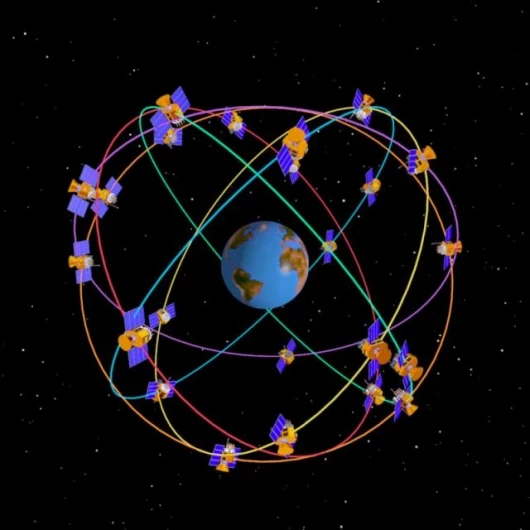June 15, 2005 The Global Positioning System is one of the wonders of the modern world. GPS has been available now in one form or another since 1978 and the full 24-satellite system was completed in 1993, making extremely accurate satellite location available to everyone – unless they were indoors, in a valley or in a city with tall buildings - any one of the common ways that GPS satellite signals can be deflected, weakened or obscured. Now there’s a new GPS weak signal tracking technology, called SuperSense, that makes GPS far more viable in many of those situations. Supersense will enable a new level of feasibility for handheld and in-vehicle navigation systems.
Announced yesterday by semiconductor solutions developer Atmel, in conjunction with u-blox this new GPS software makes accurate GPS navigation possible in building interiors, deep urban canyons, covered roads and other locations where GPS reception has previously been impossible. Previously such areas prevented effective GPS navigation due to systems' inability to effectively receive faint GPS tracking signals.
SuperSense targets mass-market, automotive and handheld, FCC E-911 Phase II-compliant GPS product applications. Of particular benefit is the high sensitive dynamic navigation performance of existing and future ANTARIS-based chipsets from Atmel and modules from u-blox. Because of ANTARIS SuperSense-based products' sensitivity, antennas can be moved to a vehicle's interior, allowing products with integrated antennas mounted in glove compartments and under seats, thus reducing automotive GPS installation costs when compared with systems requiring a separate, external antenna.
The ANTARIS GPS engine, jointly developed by Atmel and u-blox, is also ideal for indoor GPS reception. The 16-channel ANTARIS features 8,192 simultaneously operating time/frequency search windows. This substantially improves acquisition sensitivity for stand-alone and A-GPS operation, enabling satellite search and position calculation in previously GPS-dead areas. SuperSense combines superior tracking sensitivity beyond -158 dBm, low power consumption and high navigation performance. It is available as beta release when purchasing the SuperSense Evalkit or the TIM-LH GPS module. It will support the complete ANTARIS GPS portfolio from Atmel as well as TIM-LH modules from u-blox.
The Atmel ANTARIS chipset (ATR0600, ATR0610, ATR0620) uses external Flash memory to control u-blox's SuperSense. The complete GPS electronics module provides exceptional tracking of weak signals and can be integrated into a single platform applicable to multiple products thus eliminating redesign of critical RF electronics.
"The arrival of SuperSense adds a new dimension of competitiveness to our ANTARIS GPS solutions," said Uwe Barthelmes, Atmel's marketing director for communications products. "It's another example of the excellent cooperation between Atmel and u-blox."
The history of Global Positioning Systems
For those interested in exploring GPS, there are some remarkable resources on the internet and a scintillating novel we thoroughly recommend.
This article on the National Academy of Sciences Site, describes how basic research into the nature of time and time measurement contributed to development of GPS. It provides a dramatic example of how science works and how basic research leads to technologies that were virtually unimaginable at the time the research was done.
For centuries, navigators and explorers have searched the heavens for a system that would enable them to locate their position on the globe with the accuracy necessary to avoid tragedy and to reach their intended destinations.
For centuries, the only way to navigate was to look at the position of the sun and stars and work it out. Even after modern clocks were developed, making it possible to find one's longitude, the most accurate instruments could yield a position that was accurate only to within a few miles. However, when the Soviet Union launched Sputnik on October 4, 1957, it was immediately recognized that this "artificial star" could be used as a navigational tool.
The very next evening, researchers at the Lincoln Laboratory of the Massachusetts Institute of Technology (MIT) were able to determine the satellite's orbit precisely by observing how the apparent frequency of its radio signal increased as it approached and decreased as it departed--an effect known as the Doppler shift. The proof that a satellite's orbit could be precisely determined from the ground was the first step in establishing that positions on the ground could be determined by homing in on the signals broadcast by satellites. Read on ...
Other great GPS educational resources
GPS Primer by Aerospace Corporation
Historical, political and military perspectives of the GPS:
a timeline of GPS developments in political and military context, along with other historical events of interest.The GPS Toolkit : a world class, open source suite to the satellite navigation community including a comprehensive library and set of utilities for GPS research, analysis, and development.
1421 - The Year China Discovered the World
Finally, if you enjoy a detective yarn and understand the principles of navigation and the problems involved in accurately determining one’s position using a sextant and the sun, the book 1421 - The Year China Discovered the World (Published by Bantam Press (2002)ISBN: 0593051580) is a thoroughly fascinating historical detective story, written by former British submarine Captain Gavin Menzies. Menzies’ unique perspective as a seafarer of the world and an ardent student of ancient mariners’ charts saw him put together this 550 page tome upon his retirement – thoroughly researched, the book is A landmark work of historical detection that seeks to prove that the Chinese mapped the world seventy years before Columbus reached America and a century before Magellan circumnavigated the globe. Buy it here.







